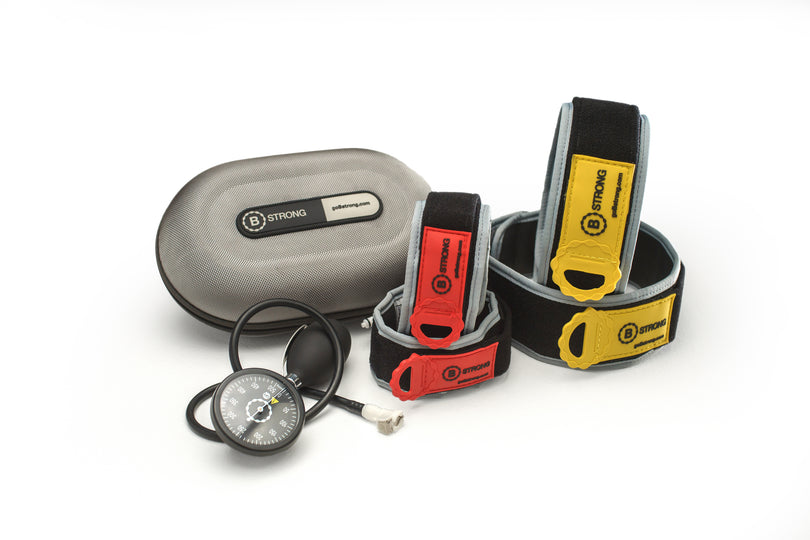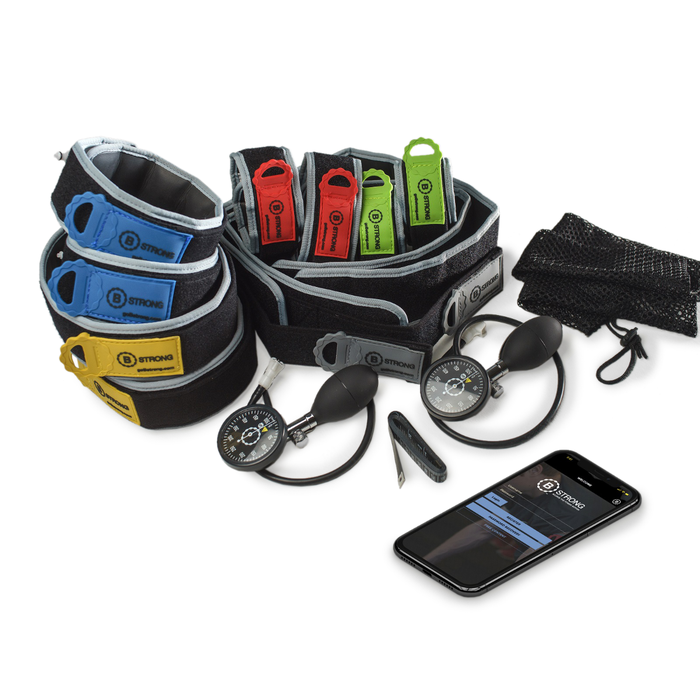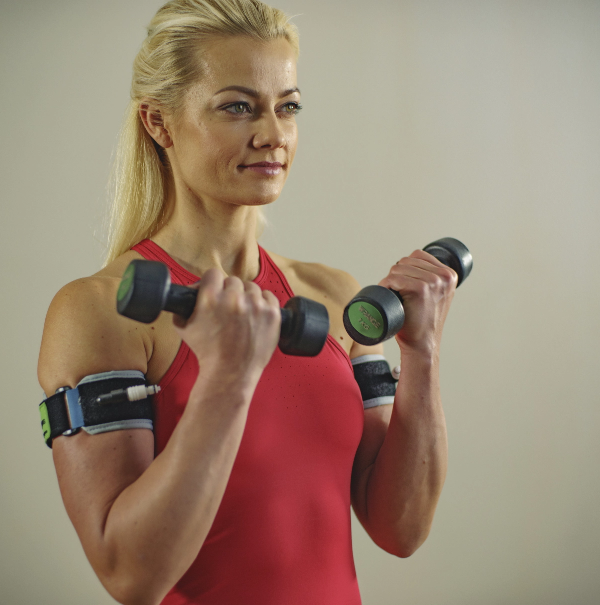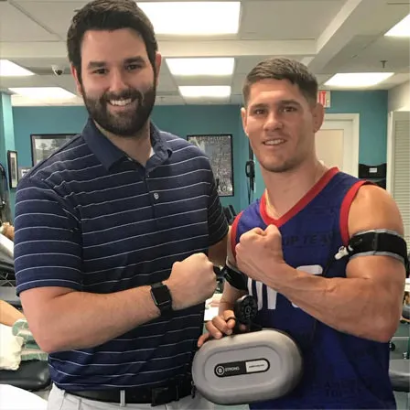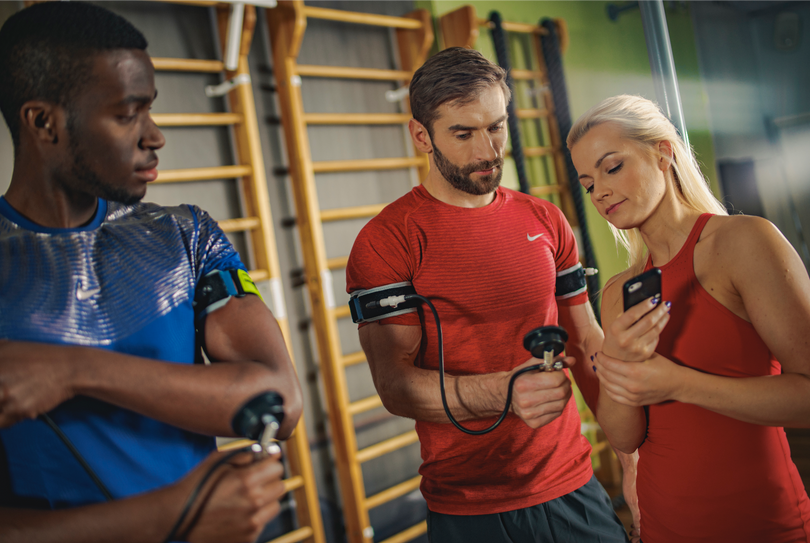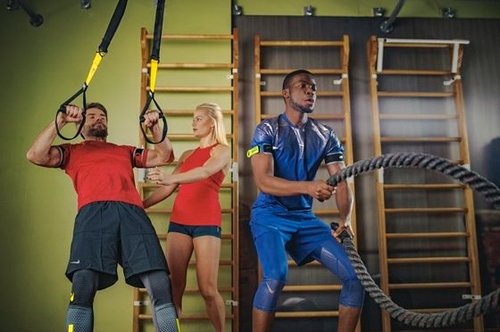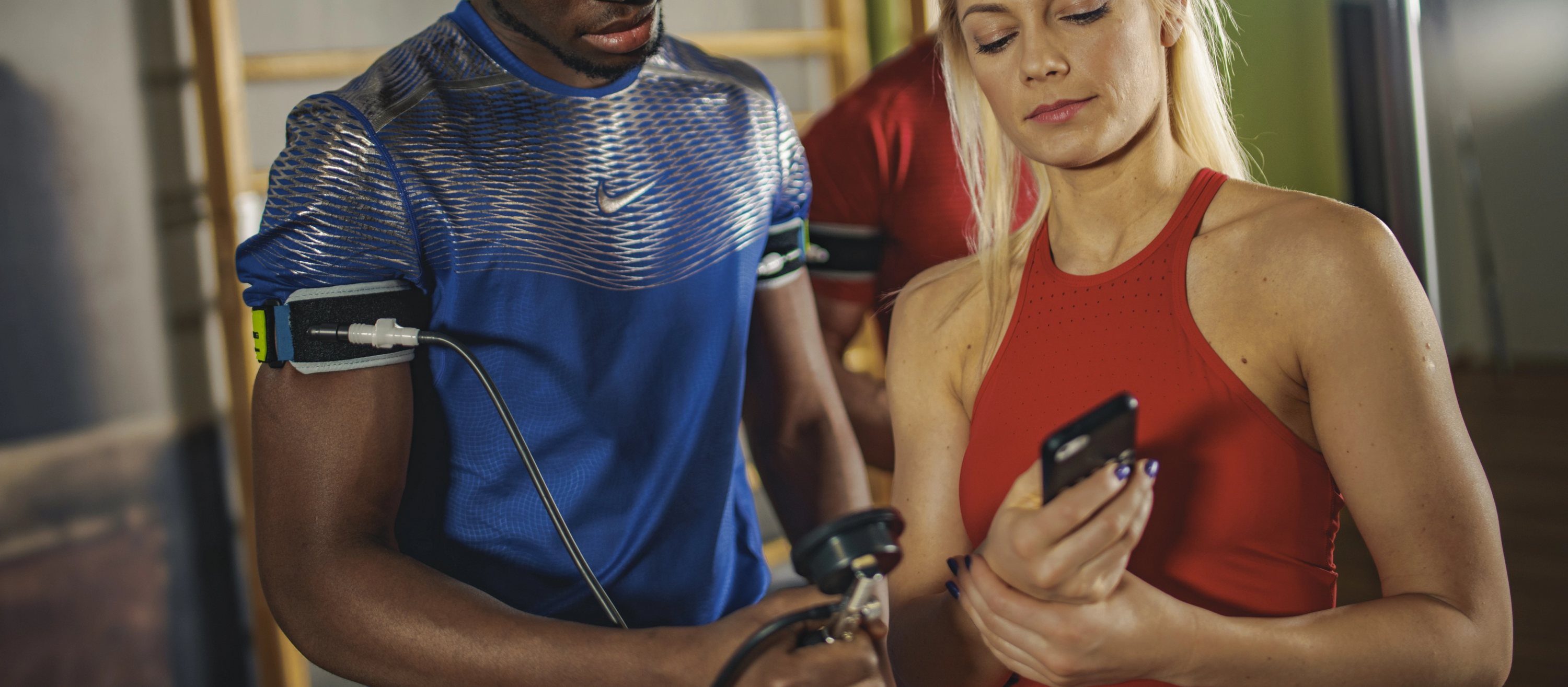MANIPULATING BLOOD FLOW CAN ACCELERATE TRAINING ADAPTATIONS AND PROMOTE RECOVERY, BUT THERE’S PAIN WITH THOSE GAINS.
The concept behind blood flow restriction (BFR) training is simple: You reduce circulation of oxygenated blood to your working muscles while training at low intensity so your body is forced to make adaptations that you would usually need to work much longer and harder to achieve.
It’s been used for recovery for years. By intermittently blocking blood flow, even if you’re laid up in bed, you can stimulate metabolic strength and fitness adaptations, so you can prevent muscle atrophy. From a recovery standpoint, BFR (performed without exercise) works to stem losses, rather than actually make gains.
In one study, a small group of athletes who had undergone ACL reconstruction either received two sessions of BFR therapy consisting of five repetitions of blood flow restriction for five minutes and release for three minutes every day during rehab, or they received no BFR therapy. (Researchers didn't pair BFR with exercise for test study.) After two weeks, the cross-sectional area of the thigh muscle decreased more than 20 percent in the athletes who did not receive BFR therapy and only 9 percent in those who did.
Outside of the rehab setting, BFR training can be used to stimulate training gains with less intensity than you typically need, so you can recover more easily, train more frequently, and (literally) squeeze more out of each session. That’s why elite level, high-performance athletes, like Olympians, have started incorporating BFR training into their routines: They can eek out marginal gains above and beyond the adaptations from conventional training alone.
It’s also useful for everyday athletes who don’t have the time for more volume of training or to recover from the intensity of conventional training, says exercise scientist Tyler Nelson, D.C., C.S.C.S., owner of Camp4 Human Performance in Taylorsville, Utah, where he practices rehab, strength and conditioning, and blood flow restriction therapy.
“With BFR you don’t need as much volume and intensity,” he says. “You also get additional benefits you wouldn’t get from your typical training because BFR is a novel stimulus your body isn't used to. When you slow down the circulatory system to the working muscle, our bodies are really good at using the available oxygen better and more efficiently over time.”
Before you try blood flow restriction training, here’s what you need to know:
How does blood flow restriction training work?

Tyler Nelson works with a client using blood flow restriction training - the B Strong Training System - while performing a deadlift
BFR involves placing an inflatable blood flow restriction or occlusion cuff (much like a blood pressure band) around the upper arms or upper legs during exercise to reduce blood fl ow to the working muscles.
The bands are typically inflated to achieve between 30 to 80 percent arterial occlusion pressure (AOP), meaning the cuff s obstruct arterial blood flow (a.k.a. blood flow from the heart to your muscles) by 30 to 80 percent. This simultaneously closes up venous fl ow (a.k.a. blood flow from your muscles back to your heart). Blood flow restriction puts the muscle under strain and creates a hypoxic environment, which triggers a cascade of metabolic adaptations. These changes include recruiting more anaerobic fast twitch fibers, angiogenesis (or increased capillary density or the number of capillaries in your muscle tissue, which allows you to deliver more oxygen-rich blood), and increased efficiency of the mitochondria (your cell’s energy producers), because your body must make do under these stressful conditions with the oxygen it has so it quickly makes these adaptations.
Once the cuffs are relaxed, blood surges back into the muscle cells, which accelerates training recovery and subsequent fitness gains.
What does blood flow restriction training feel like?
As you might imagine, this is not comfortable. There’s no getting around that, Nelson says. “I tell my athletes if they don’t like how it feels and they don’t like the experience, it’s not something that will work for them.”
The first three sessions are the worst, Nelson says, so it’s worth giving it another couple of shots if the first bout is miserable. “After three sessions, it becomes more tolerable. But it’s never not uncomfortable.”
You may experience pain and tingling, pronounced veins, and some discoloration in the skin during your sessions. “It’s scarier looking than it really is,” Nelson says.
On the bright side, research suggests that BFR exercisers may experience less muscle damage than traditional training, so you may have less delayed onset muscle soreness (DOMS) after your training sessions. That means while you might feel more uncomfortable during your workout, you might also feel less uncomfortable in the hours and days after.
How can BFR training help with muscle strength?
Lifting heavy is key for building muscle strength because it forces your body to recruit as many motor units in your muscles as possible to lift those loads. Research shows that BFR training can trigger the same adaptation without going to the gym and piling on the plates.
In a 2020 meta-analysis including more than 300 exercisers performing either heavy-load strength training or low-load resistance exercise combined with partial blood flow restriction, researchers found that the two systems worked equally well for increasing strength. The magnitude of training gains in maximal strength did not differ between the heavy lifters and the BFR trainers.
Another study from 2020 published in the International Journal of Sports PhysicalTherapy not only found that exercisers doing low load BFR training enjoyed the same increase in muscle strength and endurance as those doing heavy lifting, but also had the same magnitude of improvements in vascular function, a significant marker for cardiovascular health.
“With BFR, you don’t need as much intensity to generate that high threshold motor unit recruitment,” Nelson says. “ Research shows BFR training also inhibits myostatin, which is the primary molecule that inhibits muscle growth.”
Research shows that it also increases muscle protein synthesis rates, meaning your body is using more protein to develop muscle and strength.
This is all promising, but don’t toss out the heavy weights just yet. BFR training is an effective training tool, but it doesn’t replace traditional training, Nelson says. “BFR will never replace traditional resistance training in my opinion, because it doesn’t load your connective tissues, which allows them to accommodate the forces of sport and protect against athletic injuries .”
That’s why many athletes use it as supplemental training when they’re traveling so they don’t lose their gains. Or they’ll add BFR training on top of some conventional training, to get additional gains without the additional load that causes soreness and increased recovery time.
How can BFR training help with endurance?
The ability to use oxygen is the name of the game for success in endurance sports like cycling. BFR training forces your body to optimize its ability to use the oxygen it has, which during BFR, isn’t a whole lot.
Research shows that BFR training triggers angiogenesis, the development of additional blood vessels, creating richer capillary beds in your working muscles, which ultimately will increase how much blood you get to your muscles when you’re not wearing the cuff s and therefore improve performance. Because it also increases mitochondria and mitochondria performance, you’re better able to use that oxygen to make the energy you need for endurance performance.
In a 2019 study published in Medicine & Science in Sports & Exercise, riders who performed 30 minutes of low intensity cycling with BFR four days a week increased their quad strength and hypertrophy, as well as boosted their VO2 max by 11 percent after eight weeks despite pedaling at a super low intensity of only 40 percent of their VO2 max during the sessions.
In short, BFR training causes greater muscle fatigue more quickly and allows riders to push their training adaptations to the limits more easily. Because the training takes less time, you can conceivably make greater gains in less time.
“Instead of getting on the trainer and kicking into that low gear and pumping hard to perform your high intensity intervals, you can train at a much lower intensity and shorter timeframe with BFR, so you can do more sessions in a week for the same or larger gains,” Nelson says.
Are there other benefits of BFR training?
Nelson sees other benefits of BFR training for athletes, including “cheating your warmup” and helping increase your mental toughness .
“The purpose of warming up is to fire up your glycolytic system [the one you use to break down carbs for energy] and mitochondrial enzymes so you can start consuming oxygen at a high rate,” Nelson says. “If you want to warm up without using energy, you can do BFR for five minutes to kickstart those systems without any exercise.”
Because BFR is uncomfortable, practicing it consistently increases your tolerance to dealing with discomfort. Legs on fire cranking up Heaven’s Gate Hill? No big deal: you feel more muscle burn during any given BFR session.
“It also provides variety,” Nelson says. The body is made to adapt to the training stress you put it under—that’s the purpose of training. By adding a unique level of stress to your usual routine, you’ll make more gains.
What are the risks associated with BFR training?
Research shows that when practiced correctly, it is largely safe. However, there have been some cases of muscle damage and rhabdomyolysis in untrained people practicing strenuous exercise with BFR. Some people also feel dizzy or in rare cases faint (generally before they are accustomed to it), according to research . And as mentioned, some people might find it too uncomfortable to do regularly.
People who have a history of blood clotting disease like a history of venous thromboembolism (VTE), unstable hypertension, heart disease, varicose veins, or are pregnant shouldn’t do BFR training. People with a high risk of nerve injury, such as those with diabetes, should approach with caution. If in doubt, check with your doctor.
So should you try blood flow restriction training?
BFR is a training tool that can enhance your training. It is pricey: an arm and leg bundle can cost about $429. It doesn’t work better than conventional strength and interval work, and you still need to train with high loads for connective tissue and bone health. But it can help you maintain muscle when you’re away from the gym, boost your training gains in less time, and help you recover faster, especially from injuries.
SOURCE:
https://www.bicycling.com/training/a37980332/blood-flow-restriction-training/
Selene Yeagar
Tyler Nelson

